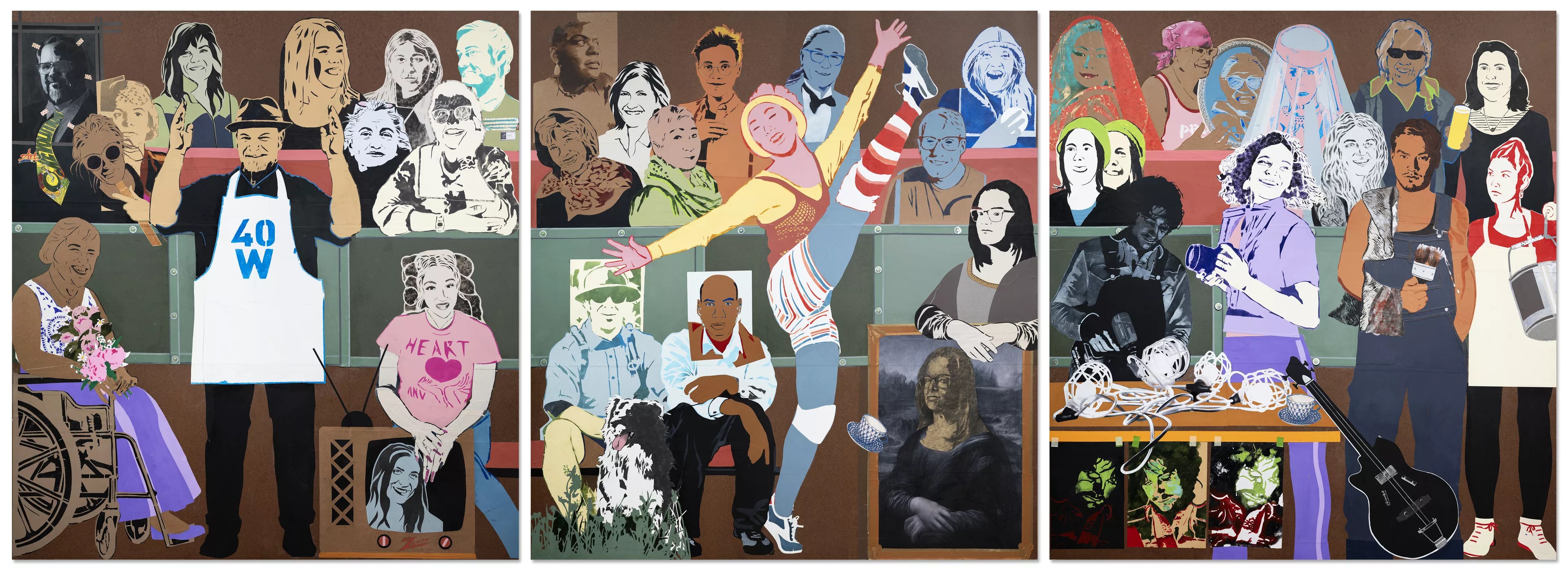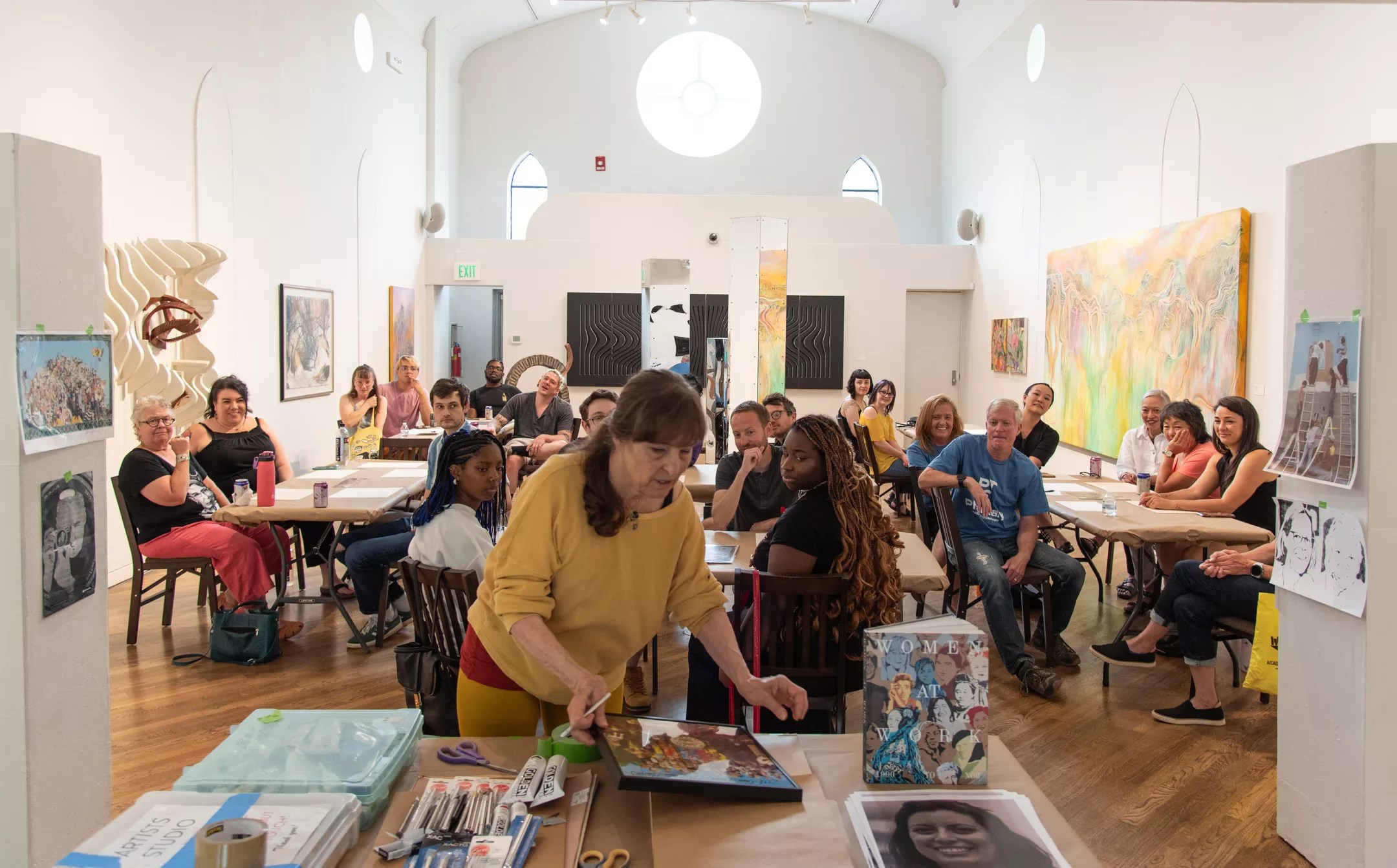
Denver Theatre District

Audio By Carbonatix
Last June, dozens of Denver residents gathered in the Emmanuel Art Gallery to celebrate a group of people who had never been directly celebrated through art before. In fact, some of the residents, who were about to make striking acrylic portraits of those individuals, had never even heard of them before.
Portrayed in beautiful photos provided by their respective local arts organizations, these 35 behind-the-scenes individuals have played essential roles in the Denver art scene, and the Denver Theatre District’s new art billboard aims to give them the recognition they deserve. The triptych collage, Catalysts, created by Jann Haworth and dozens of other contributing artists, launches Friday, March 14, and will be installed on the southern wall of the Buell Theatre for the next two years.
The billboard space at the Buell is switched out with a new piece of artwork every two years by the Denver Theatre District, which brings local nonprofits and media companies together to raise funds for public art in the downtown area through corporate advertising. The majority of the DTD’s work focuses on providing funding and opportunities for emerging artists to explore and highlight their craft.
While Denver has many wonderful art galleries, Annie Geimer, the director of special projects and curator for the DTD, often focuses on projects that showcase more public, community-oriented artwork. “A main goal of our district is to be very inviting and to make the touchstones of what we create easily appreciated by a wide variety of people,” Geimer says. “I’m always looking for work that is compelling and that is accessible.”
When news happens, Westword is there —
Your support strengthens our coverage.
We’re aiming to raise $50,000 by December 31, so we can continue covering what matters most to this community. If Westword matters to you, please take action and contribute today, so when news happens, our reporters can be there.

The lead artist on Catalysts, Jann Haworth has been a notable figure in the pop art scene since the 1960s.
Robert King
Considering Geimer’s outlook, it should come as no surprise to those familiar with Jann Haworth’s work that she would be the perfect person to bring in for one of DTD’s projects. “When I started talking to [Jann], I started realizing how incredible of a person she was and her impact as a pioneer of the pop art movement… I thought, this is a lost opportunity if we don’t do something bigger with her,” Geimer says. “When it came to her previous work that she’s done in Salt Lake City celebrating women throughout history, I was interested in how she came about that idea, and if there was a newer way we could reinvent that specifically for Denver.”
That Salt Lake project, titled “SLC Pepper” due to its emulation of Haworth’s most famous work on the cover of The Beatles’ Sgt. Pepper’s Lonely Hearts Club Band album, features dozens of stencils of historical women of varying notoriety. Among other artforms that challenge and break the rules of formal artwork, Haworth continues to gravitate toward the stenciling style as an eye-catching way to highlight people who often go overlooked by society.
“I love the fact that the [stenciling] form dwells in ‘low art,’ decorating boats and houses and walls,” Haworth says. “Stenciling is like that; a homey kind of form. And likewise, collage is scrapbooking or making screens, and I love the idea of blasting that idea and putting it to the fine art level. Stenciling is also very accessible as an art form, because you’re working from a photograph; the choices you make are very individual and the final piece shows the style that’s resident in the person.”

The stenciling process involves cutting essential features of portrait photos before painting over the photo. Here, a couple of photos and stencils dry side by side.
Shane Still
In fact, the stenciling process is so accessible that Haworth hosts workshops for each of her projects to teach artists and newcomers alike how to emulate the style and make their own stencils for the project. Each individual stencil featured in Catalysts was completed by a different Denver resident. “We invited everyone who was nominated, all of the local organizations who participated, and then Jann really likes to include local artists and run of the mill community people in this sort of project,” Geimer says.
“We’ve worked with a broad range of people [on stenciling], and it’s always similar because people have to have a lot of courage if they don’t do art and they don’t know the tools,” Haworth adds. “Most people have a humiliating story with the arts that makes them feel vulnerable. So the workshops start from that mood, and I try to be reassuring and open them up to creation before taking a step back and leaving them to it.”
Haworth’s stencil process starts with a photograph that artists are asked to cut the most striking features of the portrait out from. Once the artists are done cutting, they paint through the gaps of the photograph to create the finished painting. Haworth makes sure that the stencilers do all the decision-making when it comes to colors, fabrics and what’s cut and what isn’t. It’s a simple process, but the accuracy, clean edges and realism of the finished products speak for themselves.
Geimer herself worked on a stencil featuring Dalia Dorta de González, a board member of the Latino Alliance for the Denver Art Museum and the Latino Cultural Arts Center. “I felt a sense of responsibility to do justice to this person,” Geimer said of her stenciling experience. “I wanted to highlight her elegance and her prowess and her confidence. I didn’t want to mess up, but Jann doesn’t believe in messing up. That kind of guidance really helps you let your guard down when you’re out of your comfort zone.” Dorta de González’ portrait, shaded in a gentle blue, is featured on the left panel of Catalysts.
Though each portrait firmly rests within the same stencil stylings, they each have their own unique quirks. Those differences are highlighted by the easter eggs and other touches that Haworth added to the final collage, such as her choices to reference the way the stencil of Jeff Lambson was taped down with polka dot tape when it was sent to her, or to add a version of Claire McDonnell’s portrait that emulates the Mona Lisa. “The photograph was such a perfect mimic of the Mona Lisa, and then after the stencil was done I thought, ‘I just can’t resist doing a take on this!’ Haworth says, laughing.
After collecting all of the stencils, Haworth doesn’t shy away from breaking the rules of common layouts. Heads towards the back of the collage can be larger than ones in the front, and the centerpieces, while still eye-catching, do not dominate or overshadow the other works. To Haworth, avoiding hierarchical placement and elitism in art is core to creativity and understanding each artist’s perspective. “It’s not that a child’s drawing is less than a Matisse; they’re both fabulous,” she says. “I put outsider art and children’s art and contemporary art all on the same footing. It’s about respect.”
Respect and fairness are consistently what Haworth comes back to when determining how she honors her subjects and the artists who stenciled them. “I like the idea of honestly reflecting real people,” she says. “You’re not going to recognize these people from social media unless you’re very close to what’s happening in the Denver area, but it’s those who make the culture rich and who make life worth living. In the era of celebrity, I’m afraid we’ve gone far astray from respecting those types of people and their stories.”

The workshop for Catalysts was held in the Emmanuel Art Gallery, where Haworth’s work has been featured in the past.
Shane Still
With work like Catalysts, Haworth and DTD hope to challenge artistic narratives surrounding fame and raise awareness of the important work that local artists do every day to enrich their communities. “It’s really important during this tense and challenging era that we’re in to look towards the people who are still making Denver a place worth being,” Geimer says. “I hope the piece encourages people to look up these organizations and go to their programs. They’re so important and we want them to stick around, so we’re supporting them however we can.”
Every piece of art has a community behind it. This collage alone took a workshop group, 34 different art organizations, professional photographers, the DTD’s resources, an out-of-state artist, and of course the nominees themselves, among countless others. “Catalysts” challenges us to consider each of the individuals who make up the whole. Once we do that, we can begin to grasp the full, city-spanning scope of local art.
Catalysts will launch Friday, March 14, on the stretch of Champa Street between 13th and 14th streets; learn more on the Catalysts project website. For more on the Denver Theatre District, including upcoming events, go to its website.